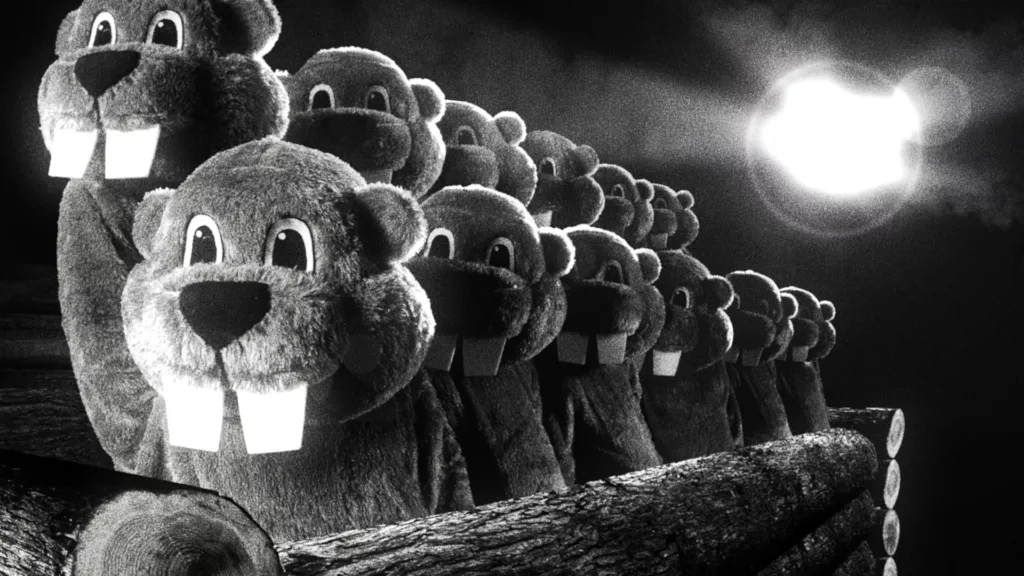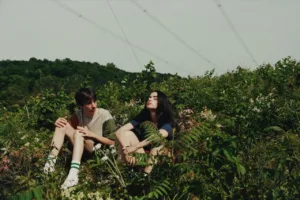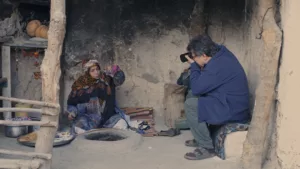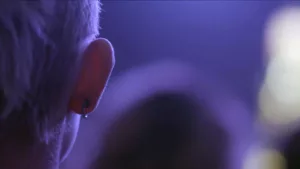
Never read your reviews, goes the old adage.
But maybe it’s not so easy for an actor to ignore a bad notice while being heckled by his own director during their movie’s hometown premiere.
“Boo!,” bellowed Mike Cheslik from the right aisle of the Oriental Theatre’s main auditorium, which was packed April 28 for the Milwaukee Film Festival debut of “Hundreds of Beavers,” a comedy made by a team with local roots. Cheslik’s jeers were aimed at lead performer Ryland Brickson Cole Tews, and frankly, Tews had it coming. After all, in the middle of the screening the actor had climbed onto the stage, pointed at his own projected, jumbo-sized face, and squealed, “It’s me!”
That anarchic routine was all part of the show, of course. Cheslik and Tews are born entertainers—they were also behind 2018’s cult favorite “Lake Michigan Monster”—and on this night their penchant for willful excess was apparent from the get-go. Filmgoers were greeted on the sidewalk by performers costumed as wolves and rabbits and Cheslik’s over-the-top introduction included an impromptu chant (“100 more years!”) beseeching the film gods to preserve the Oriental, a movie palace built in 1927, for another century. By the time the post-film Q&A devolved into a WWE-style brawl, the audience was primed to witness Tews splintering a wooden chair against an attacker dressed in a full-body beaver outfit.
While the evening blissfully channeled the showman instincts of William Castle, what happened on screen was closer in spirit to Chuck Jones. Set in a snowy, 19th-century forest, “Hundreds of Beavers” is a live-action cartoon starring Tews as a goofy fur trapper who falls for a merchant’s daughter and then must go to war against a beaver colony with grand plans for world domination. What if Elmer Fudd was humanity’s only hope? That madcap premise unfolds in a black-and-white, dialogue-free slapstick universe marked by artificial effects, copious green screens and scores of animals that are obviously just people wearing Halloween costumes. By converting his limited resources into a virtue, Cheslik has crafted an alternative visual style that plays like a wholly original, charming riposte to mainstream orthodoxy.
In other words, “Hundreds of Beavers” is both old-timey and forward-looking. The movie, which mines silent classics for inspiration and steals directly from Chaplin, certainly knows the past. My favorite homage comes courtesy of Doug Mancheski, who, as the crusty merchant, delivers an exaggerated performance that evokes James Finlayson, Hollywood’s mustachioed comic foil to Laurel and Hardy. But the vintage allusions are paired with ultramodern gags, including a sudden, blink-and-you’ll-miss-it recreation of the “Nodding Guy” Internet meme that doubled me over. Not everything in “Hundreds of Beavers” works—and it’s at least 15 minutes too long—but even in its slippery patches, the movie seems to tighten its raccoon-skin cap and continue trudging toward a new, weirder frontier.
All of my favorite movies at the 15th edition of the Milwaukee Film Festival, which closed May 4, were animated by a similar pioneering spirit.
Cinema is at a crossroads—theaters are dying, distribution models have collapsed, digital video has dented the gatekeepers—which means the time is ripe for filmmakers to challenge traditional notions of what movies “ought” to look like. During the festival, for example, I saw nearly a dozen titles presented in the boxy 4:3 aspect ratio (think of the shape of old tube TVs), including “The Eight Mountains” and “Godland,” two epics brimming with the kind of breathtaking vistas for which widescreen was invented. As our home televisions get bigger, it’s curious that the movies are deliberately shrinking in a way that was unthinkable even 10 years ago.
So commonplace has the narrower format become that when director Anthony Shim used 4:3 for his Canadian immigration drama “Riceboy Sleeps,” my mind barely registered the fact. That technical choice, though, was crucial groundwork for what would prove to be, for me, the festival’s most overwhelming third act.

Working from his own memories, Shim observes a Korean mother and her son as they struggle to assimilate to a Vancouver suburb in the 1990s. “Riceboy Sleeps” sidesteps potential clichés by focusing on the duo’s interior lives, conveying their private earthquakes through layered, mindful details captured on Kodak’s sensitive 16mm film. With idiosyncratic cutting, long takes, and camera movements that often track, circle, and pause with ethereal grace, the movie’s visual architecture has the net effect of drawing viewers closer. This adds epic emotional intensity to a story that is otherwise small in scope. The frame’s cage-like dimensions accentuate the characters’ sense of claustrophobia, but when Shim deploys a late pivot to the expansive 16:9 format, it’s not just a reprieve. It’s also a lush, exhilarating affirmation of identity, family, and home.
“Wow,” said Matt Mueller, culture editor for OnMilwaukee. “Wow,” I replied, as we tried to process the movie on the sidewalk outside the Avalon Theater on South Kinnickinnic Avenue. There may be no greater testament to the power of “Riceboy Sleeps” than how it wrecked and rendered speechless two guys who are, um, professionally verbose.

Charlotte Le Bon’s “Falcon Lake” is another Canadian triumph photographed in 4:3 on 16mm that MFF slotted into its Teen Screen division (which was surprisingly excellent this year). It shares with “Riceboy Sleeps” a natural feel for adolescence, but here the vibe is decidedly more ominous, even when the vacationing central characters, a 14-year-old boy and 16-year-old girl, fumble their way through summer mischief. Punctuated by shivery landscapes, creeping sounds, and local rumors of a haunted lake, this coming-of-age story solves a thought experiment: What if Éric Rohmer, the French New Wave poet of youth, leisure, and seduction, made a cabin-in-the-woods horror movie?

Apprehension courses equally through “No Bears,” Jafar Panahi’s fifth clandestine feature since being banned from making films in 2010. It may also be his wisest. Playing a fictionalized version of himself, Panahi appears in the movie as an Iranian filmmaker remotely directing his actors, via subterfuge, while hiding in a rural village. Once again Panahi has made an allegory about imprisonment, but this time the anger and frustration have been absorbed into a larger, more philosophical quest for answers. This is a movie about confinement, both physical and psychological; borders, both real and imagined; and myths, both destructive and enlightening.
“No Bears” signals how some stories exist in the zone between what’s real and what’s true. In fact, the two best documentaries I saw at the festival transcended the genre’s tired sit-and-get machinery to become something more adventurous.

Constructed largely out of decade-spanning home videos, “Sam Now” starts with Sam’s mother Jois vanishing without a trace. But the more compelling mystery lies within Sam: How will his mother’s absence affect him? In this three-paneled character study, Sam authentically moves from a carefree 11-year-old to an awkward 17-year-old searching for his mom to a damaged, introspective 36-year-old man. When Jois enters the documentary, she remains an incomprehensible “character” because, the viewer suspects, she is reluctant to present her true self to her family and their camera. Still, the honesty gap between Sam and Jois doesn’t matter very much, because both, in their own way, furnish complex insights about intergenerational trauma.

The term “documentary” may be insufficient to describe Alison O’Daniel’s “The Tuba Thieves,” a listening experiment that incorporates elements of nonfiction, narrative, video art, and the kind of essay film for which Chris Marker was known. Most of all, it is an experiential work about sound and the loss of sound. As with Duchamp’s conceptual art, the object we see is rarely the point; for O’Daniel, the sounds embedded inside the images are her main subject. The movie teaches you how to watch and listen as it goes, which is endlessly exciting. Boundaries are also obliterated, including the distinctions between instruments, voices, highway growls, ocean waves, etc. According to “The Tuba Thieves,” it’s all music. And it’s all cinema.
At the Milwaukee Film Festival, good movies are a dime a dozen. The special movies, though, often expand our notions of what movies can be. This year, “The Tuba Thieves” radiated such restless curiosity—but so did a frostbitten farce about hundreds of beavers.
Five Favorite Films at the 2023 Milwaukee Film Festival
- “Riceboy Sleeps” / dir. Anthony Shim, Canada
- “No Bears” / dir. Jafar Panahi, Iran
- “Sam Now” / dir. Reed Harkness, USA
- “Falcon Lake” / dir. Charlotte Le Bon, Canada
- “The Tuba Thieves” / dir. Alison O’Daniel, USA
